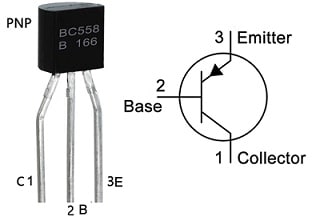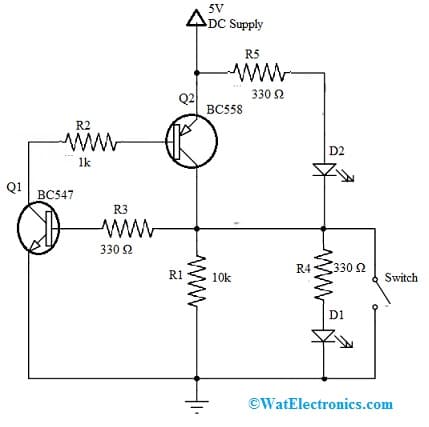The transistor like PNP operates almost similarly to NPN but the current directions & voltage polarities will be reversed. The flow of current in NPN is from the collector terminal to the emitter whereas in PNP, it is from the emitter terminal to the collector. So, a PNP transistor is generally a type of transistor where n-type material can be doped using two p-type materials. A PNP transistor is an electronic component that is controlled simply through the current supply. So the small amount of current at the base terminal is controlled by the current at the emitter & collector terminals. This article provides brief information on one of the PNP transistors namely a BC558 transistor.
What is a BC558 Transistor?
BC558 is a low-power, general-purpose PNP Silicon transistor that is available in a TO-92 package. This package is made simply with plastic or epoxy material which makes this transistor more resistant & compact. This transistor is generally used mainly for amplification & switching purposes. When this transistor is used as a switch it drives 100mA of load by 30V. The collector dissipation of this transistor is 500mW & its DC gain maximum is 800 so it can also be used for audio amplification & audio preamplifier purposes.
This transistor is designed in three different parts; BC558A, BC558B & BC558C based on the Hfe values. If the last alphabet of this transistor is ‘A’ then its Hfe value ranges from 110~220 for ‘B’ and it will range from 420 to 800 for ‘C’ value. While looking for a suitable transistor for your application based on a few factors, it is very important to look these few points on How to Select a Transistor.
Working
The working of this transistor is; that the base terminal of this transistor controls transistor’s the conductivity. Whenever the current supply is applied at the base terminal of this transistor then both the emitter & collector terminals will remain open which is known as reverse bias. So the transistor will be switched OFF. When there is no current supply at the base terminal, then the remaining terminals will be closed, so the transistor will be switched ON which is known as forward-biased.
Pin Configuration:
The pin configuration of the BC558 transistor with its symbol is shown below. This transistor includes three terminals each pin and its function is discussed below.

BC558 Transistor Pin Configuration
- Pin1 (Collector): This collector terminal allows the flow of current.
- Pin-2 (Base): The base terminal simply controls the transistor biasing.
- Pin-3 (Emitter): This emitter terminal Drains out the current.
Features & Specifications:
The features and specifications of the BC558 transistor include the following.
- The collector-to-base voltage of this transistor is -30V.
- The collector-to-emitter voltage of this transistor is -30V.
- The emitter to base voltage of this transistor is -5V.
- The saturation voltage value from collector to emitter is -60 to -650mV.
- The collector current value of this transistor is -100mA.
- The power dissipation of this transistor is 500mW.
- The DC current gain value of this transistor is 125 to 800Hfe which indicates the amplification ability of the device.
- The BW transition frequency value of this transistor is 100MHz.
- The storage temperature or junction temperature of this transistor is -65 to 150℃.
- The thermal resistance value is 250K/W.
- The noise figure of this transistor ranges from 2 to 10dB
- The typical voltage allowed across the VCE or V-BE ranges from 200 and 900 mV.
Equivalent & Complement Transistors
The equivalent BC558 transistors are; BC560, BC557, 2N3906, A1015, BC338, BC157, BD140 & BC556. These PNP transistors have the same electrical specifications. Before replacing these transistors, we have to check the pinout and the voltage details, because these specifications will become very dangerous at the circuit level. The complementary BC558 PNP transistor is the BC548 NPN transistor. The BC558 transistor’s SMD versions are; BC858 in SOT-323, BC859W in SOT-323 & BC858 in SOT-23 but the power dissipation specifications of these transistors are not the same as BC558. Few points need to be considered while replacing a transistor to know more read on Replacing Transistors in Electronic Circuits: Factors and Considerations.
How to use BC558 Transistor for Long-Term Performance?
To use a BC558 transistor in a circuit to get long-term performance, it is suggested to operate any load > 100mA. Do not drive any load > 30V and use an appropriate base resistor always with this transistor. Before connecting this transistor to the circuit, need to check its pinout. Do not operate and store this transistor in temperatures < -65 centigrade & > +150 centigrade. By connecting a base resistance to transistor is also a prevent transistor form getting damaged by fluctuations . Please refer to this link for; Choosing Base Resistance for Transistors in Electronic Circuits.
Short Circuit Protection with BC558 Transistor
Generally, short circuits commonly occur while handling electrical appliances. So these appliances stop working when a short circuit occurs in their inner circuit. So, excess current supplies throughout the appliances which can harm all the other appliances used in the home. A short circuit protection circuit is designed using a BC558 transistor to solve the short circuit trouble.
This short circuit protection circuit works like a fuse used in household electric circuits. This circuit is built with a BC547 NPN transistor, BC558 PNP transistor, 10k Ω Resistor, 1k Ω resistor, 330 Ω Resistors –3, two LEDs, and a DC power supply.

Short Circuit Protection with BC558 Transistor
Working
This short circuit protection circuit using two transistors works with a 5V DC supply. The LEDs in this circuit are simply connected to recognize the current flow & the occurrence of a short circuit. A switch in this circuit replicates the shorting of the circuit. When the switch is closed, the circuit is shorted.
Whenever the power supply is turned ON, then both the Q1 & Q2 transistors get biased & start conducting. The current supplies throughout the green color LED (D1) & it switches ON and the red color LED remains off because there is no current flow through it. So there is no short circuit unless the green color light is turned ON.
Once the switch is closed the circuit will be ‘shorted’, then the output voltage reduces to 0V because there is no potential difference. The Q1 transistor will stop conducting when the voltage at the base terminal is 0V & it is not biased for a longer time. Here, the Q2 Transistor will stop conducting because its collector voltage drops to 0V & it is not biased any longer. Now the current supplies throughout D2 RED LED and will be turned ON & supplied throughout the closed switch & the GND terminal. The flow of current is redirected through the D2 RED LED rather than damaging the whole circuit. This circuit is ideal for many electronic mini-projects.
Transistors can also be connected to a microcontroller read on interfacing a transistor to microcontroller. Before interfacing few points need to be considered. Read on the points need to be considered for interfacing a transistor to a microcontroller.
Applications
The applications of the BC558 transistor include the following.
- BC558 transistors are used in electronic circuits.
- These transistors can be used as a switch to handle any load < 100mA like LEDs, transistors, relays, ICs, and many more.
- BC558 transistor can be used as a preamplifier or an audio amplifier for any kind of signal amplification
- These are used in the Darlington pair.
- These transistors help in controlling motors for impedance buffering, used in instrumentation & robotics projects.
- These PNP transistors are used within current mirror and H- Bridge circuits.
- These transistors help in designing astable & bistable multivibrators.
- These are used in oscillator & comparator circuits.
- These are used in DIY kits and electronic projects.
- These transistors are applicable in signal amplifiers, relay drivers, buffer circuits, comparators, oscillators, and current mirror circuits.
Please refer to this link to learn more about BC558 Transistor Datasheet.
Thus, this is an overview of BC558 Transistor-pin configuration, specifications, circuit, working, and its applications. It is a low-power, PNP-based BJT available in the TO-92 package used in different kinds of general-purpose amplification and switching-based applications. This transistor drives 100mA 30V of load. Here is a question for you, what is a BC560 transistor?